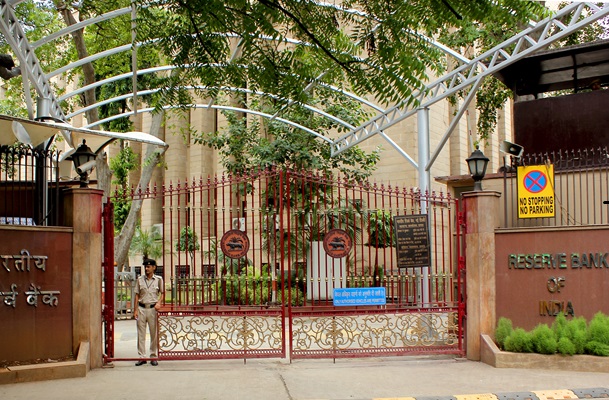.png)
RBI Must Resist Calls To Reopen The Fixed Rate Repo Window
Calls to revive the fixed repo window are gaining ground. The RBI must resist — or risk undoing a decade of hard-won liquidity discipline.

Basis Pundit writes on central banking and macroeconomics with a taste for nuance and a weakness for contrarian takes—sometimes just for a lark.
April 7, 2025 at 2:44 PM IST
Wednesday will see Reserve Bank of India Governor Sanjay Malhotra announce the Monetary Policy Committee's interest rate decision. But what will matter more are the central bank's comments on systemic liquidity and its management.
As reported elsewhere, the RBI has been reviewing its liquidity management framework and has recently consulted bankers and economists. This comes at a time when the central bank has conducted an extraordinary number of fine-tuning operations since mid-January and injected trillions of rupees in durable liquidity after its heavy dollar sales drained the market of rupees. The squeeze was worsened by routine tax outflows and currency leakages.
A recommendation from the market that has gained some currency is to bring back the daily fixed rate repo window under the Liquidity Adjustment Facility, where banks were permitted to borrow from the RBI at the repo rate.
Liquidity Lessons
Calls to bring back the window are not without merit; after all, the central bank is, anyway, holding variable rate repo operations daily, with banks and primary dealers managing to borrow at a rate just 1 basis point higher than the repo, at least in recent days. Further, a fixed window provides the certainty of a backstop in times of stress that variable rate repos—only announced some 15-20 hours before the auction is to be held—do not; after all, the RBI is not mandated to announce daily fine-tuning operations.
The question, then, is why the RBI should not just re-introduce the fixed rate repo, with some reasonable limits. There is, of course, no chance that the central bank goes back to the pre-taper tantrum era, when banks could borrow unlimited money from the RBI at the repo rate. The RBI, back then, was the lender of first resort, not last.
In July 2013, the central bank decided to cap repo borrowings. Over the next year, the cap was lowered to 0.25% of each bank's net demand and time liabilities with a further 0.75% of NDTL worth of system-wide liquidity available through 14-day variable rate term repos. The RBI, under Raghuram Rajan's governorship, had decided it could not be responsible for managing banks' books; lazy banking had to end. And while the central bank would be available in times of need, it had to stop the ready flow of funds at a fixed rate, which also happened to be the lowest possible one.
The last decade has shown that the RBI’s efforts to build an all-weather liquidity framework have fallen short. To be fair, the challenges were considerable. In early 2016, Raghuram Rajan had outlined a plan to shift systemic liquidity from deficit to near-neutral over two years. But six months later, demonetisation flooded the banking system with excess liquidity, derailing the plan. Less than two years on came the IL&FS crisis. By 2019, with the inflation-targeting regime still under three years old, the economy had begun to slow. Then came the pandemic, followed by the Russia-Ukraine conflict. And once it became clear that Donald Trump was returning as US president, the RBI was forced to intervene in the forex market like never before to stem the rupee’s slide.
Throughout these trials and tribulations, the RBI did what it could to keep the weighted average call rate close to the repo rate. Except during the pandemic, when the reverse repo became the de facto policy rate, the RBI has been targeting the wrong operating rate. The weighted average call rate hasn’t reflected true funding conditions for years.
Over the last decade, volumes in call have fallen so much that they constitute just 2% of total money market volumes. It is no wonder that the RBI in December approved the creation of the Secured Overnight Rupee Rate, or SORR, to take into account lending in the triparty and market repo segments. These rates are usually 20-30 basis points lower than the call rate and paint a more precise picture of financial conditions. What remains to be seen is whether the RBI will make the SORR the operating target of monetary policy.
While some still argue that the weighted average call rate has merit as a monetary policy operating target, and that limited liquidity at the repo rate does not compromise the framework, the return of a fixed rate repo window would mark a step backward.
Its return as a source of readily-available funds with no uncertainty about the borrowing cost would undo all the work the RBI has done to make banks more responsible for their books. It would also be an admission of RBI’s failure to move to 14-day operations.
Market Evolution
In a system without the fixed rate repo window or a similar option that does not carry stigma— we are looking at you, Marginal Standing Facility— banks are required to accurately predict their inflows and outflows over a longer time horizon than just one day. While certain changes in the Indian financial system have definitely made this more difficult— the advent of mobile and internet banking, for instance, has led to an increased preference for liquidity— the RBI has not helped by what can only be called the mismanagement of the impact of its own actions.
Consider the massive dollar sales it has conducted since September 2024. In the last quarter of 2024 and the first month of 2025, the central bank sold a humongous $217 billion on a gross basis. However, it only started to take real steps to infuse durable rupee liquidity in December, when it announced a 50-basis-point cut in the Cash Reserve Ratio. Surely, when the RBI knew exactly how much it was intervening in the forex market in October and November, why wait until December to counter its adverse impact?
Call it a coincidence—if you know, you know—or a lesson learned the hard way, but the central bank has been fairly proactive since mid-January and receptive to ideas from the market. The suggestion to revive the fixed rate repo window likely stems from making the most of this openness. But the RBI should know that if it gives an inch, the market will take more than a mile.
If the RBI really wants banks to manage their books more effectively, it must help them better predict liquidity conditions. This will require greater transparency from the RBI as well as the government: data on cash balances should be disclosed frequently, and both the Centre and the states must become more efficient and deliberate in their spending and borrowing decisions.
The RBI is well aware of the dangers of the fixed rate repo window—a point the Urjit Patel committee made without mincing words in its 2014 report: "Provision of overnight liquidity on an enduring basis at the overnight repo rate also compromised liquidity/treasury planning by banks themselves resulting in this function being in effect shifted to the RBI and thereby stunting the growth of the market spectrum to the overnight segment alone, disincentivising the development of a term money market; the LAF to a degree has become a conduit for gaming central bank liquidity and substituting for efforts to access market liquidity".
We may not get a final decision on Wednesday. But, frankly, it should not even be up for discussion.
Tailpiece
There is merit on both sides of the debate—especially in a world where central banks must navigate persistent and unpredictable shocks. But the conversation cannot remain limited to the return of the fixed-rate repo. It is time for the RBI to constitute a formal committee, with external members co-opted alongside internal officials, to undertake a comprehensive review of the liquidity management framework.
Several foundational questions now require clear answers: What should be the level of core liquidity the RBI guarantees during tightening and easing cycles? What should be the framework for intraday liquidity in a system operating on 24/7/365 banking and real-time settlements? Should the liquidity framework continue to anchor the overnight rate, or should it evolve to explicitly reflect the term structure? Should both the operating target and liquidity conditions be variable, or should the operating rate be firmly managed while liquidity operations flex around it, irrespective of the quantity required?
The LAF today is caught between stated intent and operational response—targeting the overnight rate, yet reacting inconsistently across the curve. This weakens both policy signalling and transmission. The framework must resolve its internal contradictions. The challenge is not about choosing between fixed or variable rate windows, but about designing a liquidity regime that is disciplined, transparent, and structurally coherent. -- By BasisPoint Groupthink



